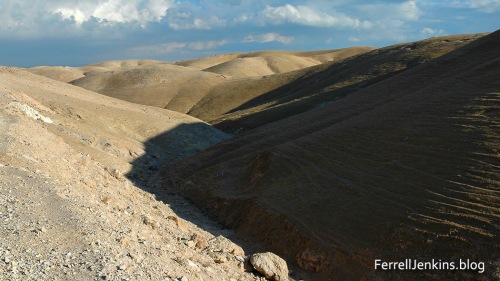
A portion of the Judean Wilderness is displayed in Green on this map, but it is a very dry area of the country. The walking trip from Jericho to Jerusalem takes at least 7 hours and 30 minutes. Made with BibleMapper.
John the Baptist preached in the wilderness of Judea (Matthew 3:3), and Jesus was tempted in the wilderness (Matthew 4:1). Jesus spoke to the crowds about John this way:
What did you go out into the wilderness to see? A reed shaken by the wind? (Luke 7:24 ESV)
The wilderness (Greek eremos) of Judea is described this way in Bauer (BDAG):
Of the Judean wilderness, the stony, barren eastern declivity of the Judean mountains toward the Dead Sea and lower Jordan Valley.

The wilderness of Judea a short distance west of Jericho. The shadows constantly change the appearance of the wilderness. Photo by Ferrell Jenkins.
The Hebrew word for this wilderness is midbar. Charles F. Pfeiffer said the wilderness of Judea,
is the region of rugged gorges and bad lands in the eastern part of Judah where the land slopes off toward the Jordan Valley. In ancient times this area was infested with wild animals. Except for a brief time during the spring rains the wilderness is arid. (Baker’s Bible Atlas, 201)

The Saint George monastery hangs along a cleft in the wilderness of Judea where the Wadi Kelt runs from near Jerusalem past Jericho. Notice the beautiful color shades here. Photo by Ferrell Jenkins.
Many people who read the Bible in English, without checking into the matter, think of the wilderness as being a place filled with wild growth and underbrush. Jesus’ question to the crowds indicates that no reeds are to be found in the wilderness. In this case a picture really is worth a thousand words. This shows one of the many changing views one might see in the wilderness. This one was made in the month of November and shows a view west toward Jerusalem.
The wilderness of Judea stretches from the eastern slope of the central mountain range to the Jordan River. Of course, it extends much farther south along the Dead Sea.







You must be logged in to post a comment.